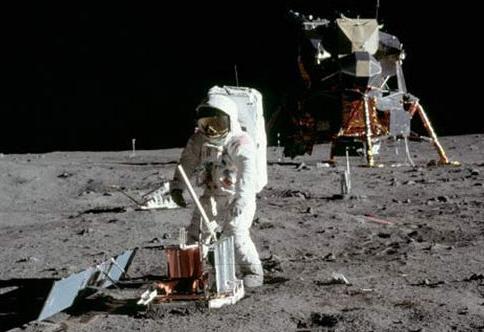
INTRODUCTION
On Earth there is a now a vast network of seismometers (instruments to measure the short period motions of the surface) across the globe. These serve two purposes. One is for scientific research and the other is for disaster mitigation. The former allows us to determine the nature of the Earth beneath and around us. The latter allows us to plan to reduce the impact of eearthquakes on civilisation. Although we cannot yet predict earthquakes in any useful sense, a knowledge of area seismicity can direct building engineering codes, specific detections can be used to produce warnings of tsunamis and aftershocks and also, in remote areas, inform rescue operations of the likely areas of maximum destruction.
The Apollo missions were the first spacecraft to carry seismometers to another world. All six missions that landed on the lunar surface carried seismometers of some type, the first on July 1969 and the last on December 1972. Some were active experiments and some were passive. Much was learnt about selenology through these experiments. For the first time comparative seismology was possible.
On November 1976, a US Viking spacecraft soft landed upon Mars and among its many instruments it carried a seismometer. In 546 days of operation, it only detected one areoquake, believed to have been about magnitude 6. The big problem on Mars is the high gusty winds that create a large background noise. We will probably have to wait until a seismometer can be placed well underground before we will learn more about Martian seismicity.
LUNAR SEISMOMETERS
Seismometers were deployed on the moon by all six Apollo missions (Apollo 11, 12, 14, 15, 16 & 17). These were part of the ALSEP package (Apollo Lunar Surface Experiments Package). The instrument deployed by the Apollo 11 team only worked for three weeks, although it provided useful initial data. The NASA image below shows Buzz Aldrin deploying this instrument.

The seismometers deployed by Apollo missions 12, 14, 15 and 16 were of a more advanced design - due to the longer time available for deployment. The Passive Seismic Experiment (PSE) instrument, is shown below in reality and in diagrammatic form:
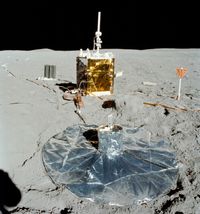 |
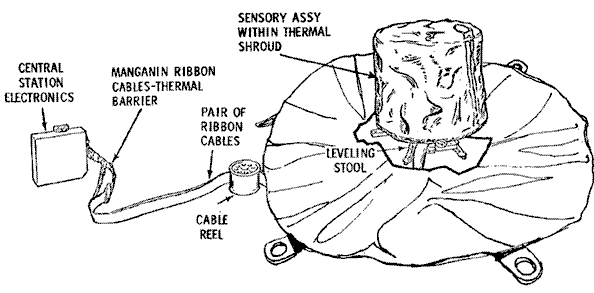
|
Apollo 17 did not bring a PSE to the moon, but had an advanced active seismic experiment to profile the crustal area around the spacecraft. It also deployed a Lunar Surface Gravimeter (LSG) that was meant to detect cosmological gravity waves and lunar tidal stresses. Due to a manufacturing defect it never fulfilled its original function, but was later used as a sensitive seismometer at a specific frequency, and detected moonquakes on the lunar farside.
The four PSE instruments of Apollo's 12, 14, 15 and 16, formed a network that was to prove very useful in triangulating the source positions of the many thousands of sesimic events that were recorded. The lunar locations of the instruments in this network are shown in the map below:
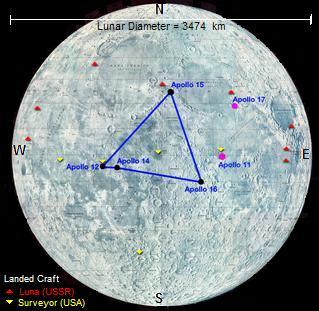
The triangle is close to equilateral with sides around 1200 km in length. Each PSE contained 4 seismometers. Three of these were orthogonal long-period instruments with axes north-south horizontal, east-west horizontal and vertical. The fourth instrument was a short-period vertical seismometer. The long period sensors were sampled at ~7 Hz and the short period sensor at ~50 Hz.
The ALSEP system and instruments were controlled by commands from Earth. The stations ran from deployment until they were turned off on 30 September 1977 due primarily to budgetary considerations. Additionally, by 1977 the RTG power packs could not run both the transmitter and any other instrument, and the ALSEP control room was needed for the attempt to reactivate Skylab. The four Apollo PSE seismometers functioned for up to eight years until they were permanently switched off.
LUNAR SEISMOGRAMS
The following (after Nakamura et al) is an example of the seismograms received from the PSE network. They show the three main types of seismic events that have been recorded on the moon.
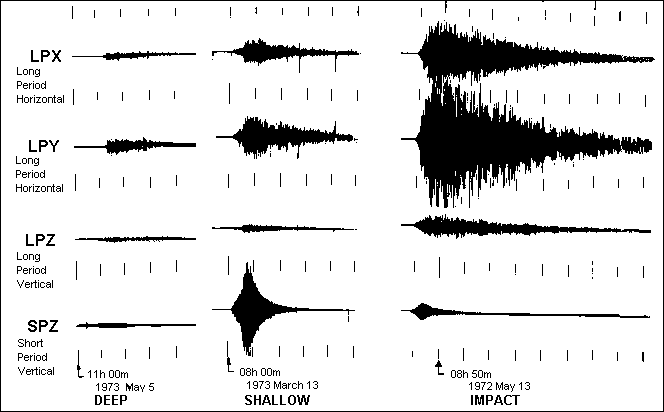
These seismograms showed marked differences from their terrestrial counterparts. Lunar quakes have higher frequencies and they ring or reverberate for a long time. This makes it hard to distinguish the different phases, as the primary phase (P) continues at high amplitude and obscures the secondary (S) phase. [ The P wave is a longitudinal wave, like a sound wave, where the particle motion is along the direction of propagation. The S wave is a transverse wave, like a wave on a rope, in which the particle motion is transverse to the direction of propagation]. The time marks on the above seismograms are spaced 10 minutes apart.
The reverberation of the moon led some people to initially ask if the moon was hollow and rang like a bell when hit. It is now generally believed that the lack of damping of lunar seisms is due to the lack of water in lunar rocks, water acting to damp seismic energy on Earth.
There are four types of seismic events that have been observed with the Apollo PSE network:
Deep Lunar Quakes
These occur deep within the lunar interior, at depths of 700 to 1000 km. This is comparatively much deeper, as a fraction of the lunar radius, than any terrestrial quakes. These events are quite frequent and appear to come from a limited number of foci (~100). That is, they appear to be 'nested'. The seismograms of quakes from the same focus are very similar to one another, and each focus seems to become active at a definite time of the month. These type of quakes thus show distinct periodicity with periods of both 14 and 206 days. It is believed that terrestrial and solar tidal forces account for these respectively. Although these are frequent events the total energy associated with them is quite low. Most are less than magnitude 2.
Shallow Lunar Quakes
These are relatively infrequent, have shallow foci, and are quite sporadic with no discernible pattern in the position or time of occurrence. A total of only 28 events were recorded over eight years (~ 3 - 4 per year). These events are most like terrestrial intra-plate tectonic events. Although infrequent, they can be significant - seven of the 28 events were estimated to be magnitude 5 quakes. This would be sufficient to pose a hazard to a lunar habitat, possibly breaching seals and venting the contained atmosphere.
Impact Events
These are the result of the lunar surface being hit with meteoroids or man-made objects. Nine artificial impacts were generated on the lunar surface as an aid to calibrate the seismometers. These were a combination of the Saturn third stage rockets and the ascent stages of the lunar modules. Because the masses of the objects and the exact times and velocities of their impacts were known, their impact energy could be calculated, and the travel times to the various seismometers could be accurately determined. Thousands of impact events have been recorded. The long-period sensors detected ~ 1700 events with estimated masses from 0.1 to 50 kg, while the short period sensors detected many more numerous impacts from smaller meteoroids. These events are an important source of information on the interplanetary natural debris environment.
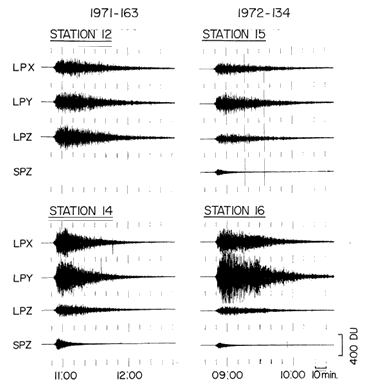
INTERPRETATION
Analysis of the lunar seismic data has continued in the decades since the seismometers were shut down. Better signal processing techniques have refined and revised our ideas of the lunar interior. It is interesting to note how ideas of the lunar interior have changed over the last 70 years. To do this we need to first consider the bulk properties of the Earth and the Moon.
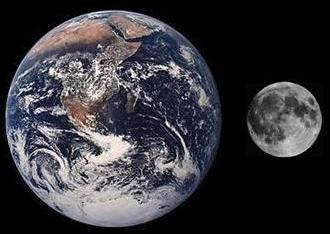
|
PARAMETER EARTH MOON Radius(km) 6400 1737 Mass(kg) 6.0E24 7.3E23 Density(kg/m^3) 5515 3344 Gravity(m/s^2) 9.8 1.6 EscapeVel(km/s) 11.2 2.4 |
Based purely on density it was initially thought that the Moon could not have a metal core. Many also thought that the interior would be in the solid phase throughout.
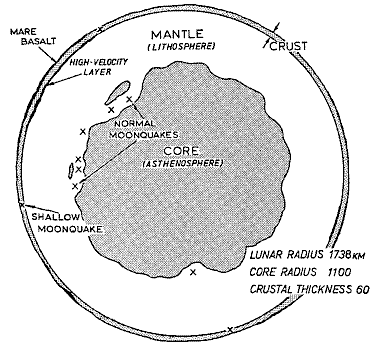
|
This is an early post-Apollo suggestion for the lunar interior. Compared to the Earth it was thought that the lunar layers were quite irregular with large inhomogeneities. A calculation of simple model pressures and temperatures deep in the moon probably should have brought realisation that the 'core' boundary could not be as irregular as shown. |
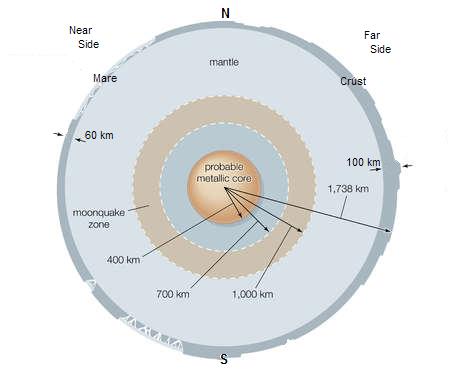
| A more realistic model is shown here. Spherical symmetry now prevails. The zone in which the deep moonquakes originate is shown in light brown. This lies at radii of 700 to 1000 km, which corresponds to depths of ~ 700 to 1000 km. |
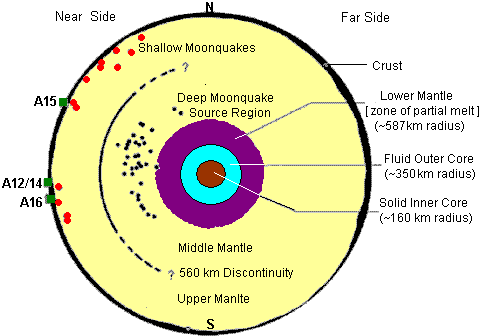
| Another version of the lunar interior recognises the possibility of a partially molten core. Further revision of this model suggests a solid inner core out to a radius of 240 km followed by a fluid outer core out 330 km. Above this would be the lower mantle partially molten out to a radius of 480 km. The deep moonquake zone is then above this region. |
The truth is that at present the available lunar seismic data is insufficient to accurately constrain models of the deep lunar interior. It has even been said that the tentative evidence for a lunar core comes from just one far-side meteorite impact that was sufficiently strong to be detected by more than one nearside Apollo seismic station in eight years of operation.
Most of the knowledge about the size and state of the core has come, not from seismic data, but from studies of the Moon’s moment of inertia, libration movements from laser retro-reflector analysis, and electromagnetic induction studies . Recent (2011) reanalysis of seismic data has added to these measurements.
CONCLUSIONS
It is obvious that new seismometers need to be placed on the moon as an urgent priority in the space program. From a scientific view more data, particularly from the far side, is needed to refine and constrain models of the lunar interior. Continuous monitoring of impact events is needed to watch the interplanetary meteoroid flux. This is a lot easier on the moon than it is on Earth due to the lack of an atmosphere and the high-Q of the moon which makes global detection of impacts possible with a limited number of sensors. Lastly, monitoring of shallow moonquakes is essential to provide a good probability model and source locations. Both of the two last points are vital for hazard assessment and planning if any infrastructure is to be put on the Moon.

 Australian Space Academy
Australian Space Academy